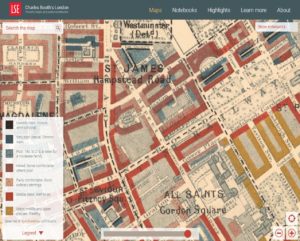 This post has kindly been written for us by Seif El Rashidi, Project Development Officer for the HLF ‘Layers of London’ Project.
This post has kindly been written for us by Seif El Rashidi, Project Development Officer for the HLF ‘Layers of London’ Project.
Charles Booth’s London (http://booth.lse.ac.uk/) is a new digital resource created by the London School of Economics and Political Science as a means of sharing Charles Booth’s great work, his Inquiry into the Life and Labour of the people of London, undertaken between 1886 and 1903.
The Inquiry was a survey of working class London, best known for one of its outcomes: The Booth Poverty Maps, which show poverty levels on a street-by-street basis. What is remarkable about the survey is its thoroughness – it looked at the both working and living conditions, as well as at the religious life of the city, going into an extraordinary level of detail in order to produce simple, clear colour-coding denoting the economic and social status of the residents. Even more significant is that 450 of Booth’s field books survive, providing rare insights into the lives of Londoners of all walks of life at the end of the Victorian period, as experienced from this ambitious and rigorous first-hand survey. Most of these field books have been digitised and are available as an integral part of this website.
Sample entries include: “Oak Place – flagged passage, gas workers, clean faces, well fed….. (Booth/B/367)
…. “on the side is a common lodging house for women of a disorderly character. Two specimens were parading the street and objurgating the deputy with a very choice selection from their vocabulary.” (Booth/B/354)
and “All good working class, Kinnerton is a great street for letting; the public house at the corner of Motcombe Street is used as is the small barber’s shop on the west side. (Booth/B/362)
These illustrate just how valuable this survey is in capturing the life of London at the end of the 19th century, bringing the city alive through brief but telling descriptions, many of which fuel the imagination. Many of these accounts were obtained by following the police on the beats around different neighbourhoods of the city. Incidentally, the City (capital C) was not included in the survey, which otherwise spans the area from Chiswick to Greenwich, and from south Brixton in the south to Upper Holloway in the north.
The new website is truly a visually-appealing, user-friendly creation, with the contextual blurbs broken down into short paragraphs, providing clear information, and ensuring that all the practicalities, like referencing, are easy to find. The two main components of the website are the map and the notebooks, the latter with specific sections on Jewish London, Stepney and Bromley Workhouses, and Police notebooks.
Notebook pages are summarised to indicate which streets are mentioned on each page, as well as any other key information, for example:
“Irish inhabitants Paradise Walk. Sloane Court, Burton Court, Queen’s Road….”
Users can search the map by place name. The results appear with three distinct classifications: place names in contemporary usage, 1898 landmarks corresponding to that name, and 1898 parishes. This is just one example showing the thought that has gone into making this website easy to use. It pre-empts problems that commonly arise in searches for place names on a historic map.
Relevant content from the notebooks appears across the map and is very easy to access. Even better, notebook content has been digitised at an excellent resolution, and can be downloaded and printed. Furthermore, material is in the public domain.
The Highlights section present a thematic selection of excerpts, focusing on drinking and drugs, prostitution, and immigration –evidently a pertinent topic, even then.
Charles Booth’s London is, in many respects, an exemplary project, especially in its aims, and ease of use, omitting the need for lengthy instructions. Many a project could learn volumes from its slickness, and its commitment to sharing valuable information. It is positively helpful – like an enthusiastic and supportive librarian, except digital. As such, the only shortcomings seem to be trivialities (that the ‘About’ section is at the bottom of the page, and maybe a brief introductory blurb at the top would have been useful; and that subheadings are not clickable, necessitating lots of ‘Discover’ buttons instead). In spending a good deal of time discovering the work of Charles Booth and his team, my one grievance is that their handwriting was often spidery and hard to read – with a generous sprinkling of abbreviations like 3 ½ st. (presumably storeys?) To LSE library’s credit is the fact that these are the few anomalies on an otherwise highly-legible website.

You’ve gotten astonishing information in this article.
Agreed, Charles Booth’s London (at https://booth.lse.ac.uk/ although easily found on Google) is a good amalgam of the old LSE Booth site and the PhoneBooth interactive map. I used a Windows 10 tablet to consult the site on the go in London and performance was fine.
The notebooks are easily read in the page-turning device, which usefully displays searchable snippets as well as links to the map. However, searching the Notebooks can throw up cases tagged “Why can’t I access all of the notebooks?”. The linked explanation is that some notebooks have yet to be digitized but can be consulted at LSE’s library. Hopefully these will one day be added to enrich an already bountiful resource.